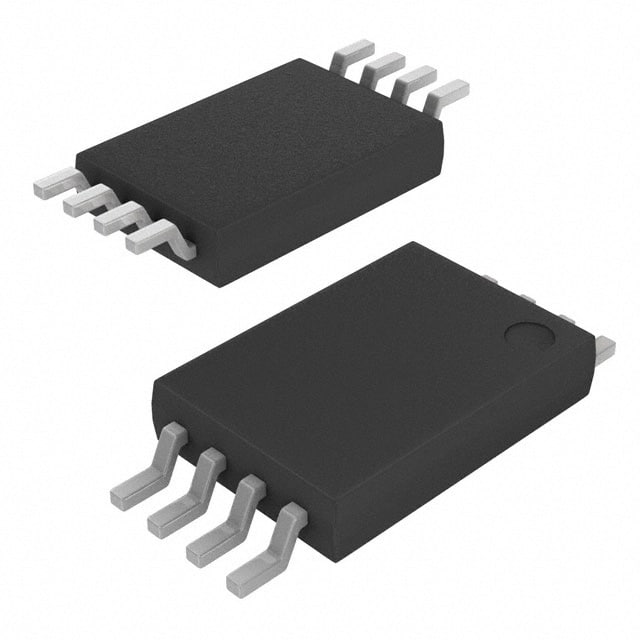CAT25040YI-G
Product Overview
Category
CAT25040YI-G belongs to the category of Serial EEPROM (Electrically Erasable Programmable Read-Only Memory) integrated circuits.
Use
This product is commonly used for non-volatile storage in various electronic devices, such as microcontrollers, automotive systems, consumer electronics, and industrial applications.
Characteristics
- Non-volatile memory: The CAT25040YI-G retains data even when power is disconnected.
- High storage capacity: This EEPROM has a storage capacity of 4 kilobits (512 bytes).
- Serial interface: It utilizes a serial communication protocol for easy integration into different systems.
- Low power consumption: The CAT25040YI-G operates at low power levels, making it suitable for battery-powered devices.
- Wide operating voltage range: It can function within a voltage range of 1.8V to 5.5V.
- High reliability: This product offers excellent data retention and endurance characteristics.
Package
The CAT25040YI-G is available in an 8-pin SOIC (Small Outline Integrated Circuit) package.
Packaging/Quantity
It is typically supplied in tape and reel packaging, with a quantity of 2500 units per reel.
Specifications
- Memory Capacity: 4 kilobits (512 bytes)
- Interface: Serial I2C (Inter-Integrated Circuit)
- Operating Voltage Range: 1.8V to 5.5V
- Operating Temperature Range: -40°C to +85°C
- Write Endurance: 1 million cycles
- Data Retention: 100 years
Detailed Pin Configuration
The CAT25040YI-G features the following pin configuration:
- VCC - Power supply voltage
- SDA - Serial data input/output
- SCL - Serial clock input
- WP - Write protect input
- VSS - Ground
- NC - No connection
- NC - No connection
- NC - No connection
Functional Features
- Byte and Page Write Operations: The CAT25040YI-G supports both byte and page write operations, allowing flexible data storage.
- Software Write Protection: It offers software-controlled write protection to prevent accidental modification of stored data.
- Sequential Read Operation: This EEPROM allows sequential read operations, enabling efficient retrieval of stored information.
- Self-Timed Programming Cycle: The programming cycle is self-timed, simplifying the integration process.
Advantages and Disadvantages
Advantages
- High reliability and endurance
- Low power consumption
- Wide operating voltage range
- Flexible write operations
- Software write protection
Disadvantages
- Limited storage capacity compared to higher-capacity EEPROMs
- Relatively higher cost per kilobit compared to larger memory devices
Working Principles
The CAT25040YI-G utilizes an electrically erasable floating-gate transistor technology to store and retrieve data. It employs a serial I2C interface for communication with the host system. When writing data, the device applies a high voltage to the floating gate, altering its charge state. During read operations, the stored charge on the floating gate is measured, determining the logic level of the bit.
Detailed Application Field Plans
The CAT25040YI-G finds applications in various fields, including:
- Microcontrollers: Used for storing configuration settings, calibration data, and program code.
- Automotive Systems: Employed in electronic control units (ECUs), instrument clusters, and infotainment systems for data storage.
- Consumer Electronics: Utilized in smart TVs, set-top boxes, and audio equipment for firmware storage and customization.
- Industrial Applications: Applied in industrial automation, sensors, and control systems for data logging and parameter storage.
Detailed and Complete Alternative Models
- CAT25080YI-G: Similar to CAT25040YI-G but with double the storage capacity (8 kilobits).
- CAT25160YI-G: Offers 16 kilobits of storage capacity, suitable for applications requiring larger memory.
- CAT25320YI-G: Provides 32 kilobits of storage capacity, ideal for more data-intensive applications.
These alternative models offer increased storage capacity while maintaining similar characteristics and functionality to the CAT25040YI-G.
Word count: 590 words
Senaraikan 10 soalan dan jawapan biasa yang berkaitan dengan aplikasi CAT25040YI-G dalam penyelesaian teknikal
Sure! Here are 10 common questions and answers related to the application of CAT25040YI-G in technical solutions:
Q: What is CAT25040YI-G? A: CAT25040YI-G is a serial EEPROM (Electrically Erasable Programmable Read-Only Memory) chip manufactured by ON Semiconductor.
Q: What is the storage capacity of CAT25040YI-G? A: CAT25040YI-G has a storage capacity of 4 kilobits, which is equivalent to 512 bytes.
Q: What is the operating voltage range for CAT25040YI-G? A: The operating voltage range for CAT25040YI-G is typically between 2.5V and 5.5V.
Q: What is the maximum clock frequency supported by CAT25040YI-G? A: CAT25040YI-G supports a maximum clock frequency of 10 MHz.
Q: Can CAT25040YI-G be used for storing program code or firmware? A: Yes, CAT25040YI-G can be used for storing small program code or firmware due to its limited storage capacity.
Q: Is CAT25040YI-G suitable for automotive applications? A: Yes, CAT25040YI-G is designed to meet the requirements of automotive applications and is qualified to AEC-Q100 standards.
Q: Does CAT25040YI-G support both read and write operations? A: Yes, CAT25040YI-G supports both read and write operations, allowing data to be stored and retrieved from the chip.
Q: What is the typical endurance of CAT25040YI-G? A: CAT25040YI-G has a typical endurance of 1 million write cycles, ensuring reliable data storage.
Q: Can CAT25040YI-G operate in harsh environmental conditions? A: Yes, CAT25040YI-G is designed to operate in a wide temperature range (-40°C to +125°C) and can withstand high levels of shock and vibration.
Q: What interface does CAT25040YI-G use for communication with microcontrollers? A: CAT25040YI-G uses the industry-standard SPI (Serial Peripheral Interface) protocol for communication with microcontrollers.
Please note that these answers are general and may vary depending on the specific datasheet and application requirements.


